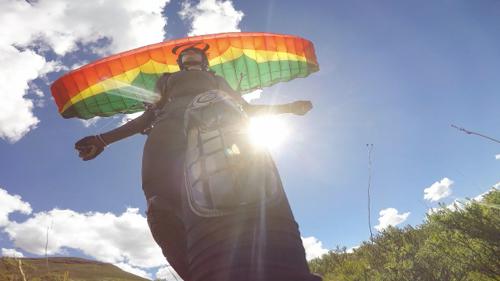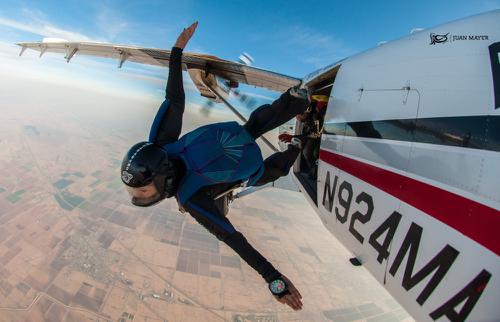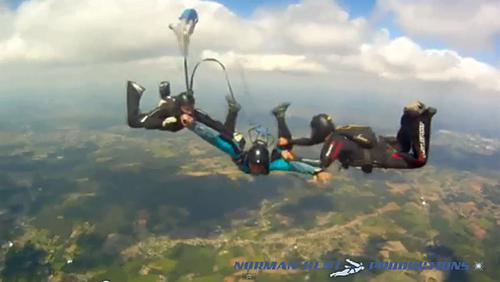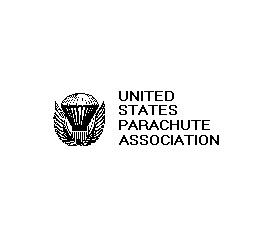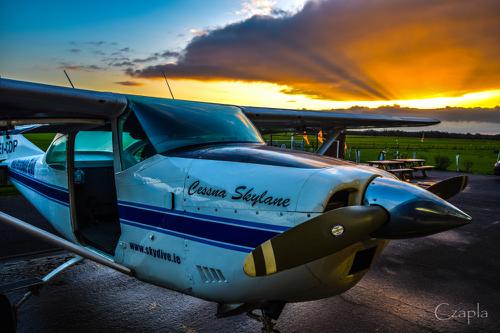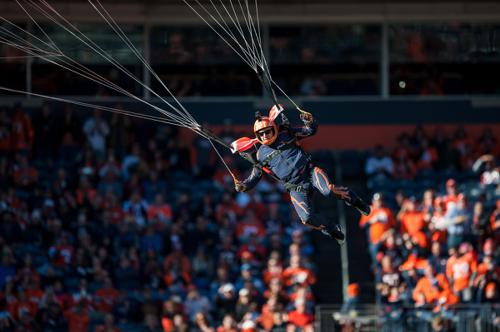The Skydiving Handbook - Chapter 6 (Canopy Performance)
Your square parachute is the result of two decades of design refinement. Like a glider, it can fly straight and level or turn, slow down, spin, and even stall. As the pilot, where you land and how you land is totally up to you. Practice, combined with a clear understanding of how your parachute works, will allow you to land softly, exactly where you want to, every time.
When your parachute is inflated, the pressurized air filling the tailored cells causes it to take on a wing shape. A parachute has a fixed angle of incidence, built into it by the length of the lines. The "A" lines in front are shorter than the "D" lines in back, causing the wing to point slightly down. It essentially flies forward and down on the slope of the angle built into it. This angle causes it to fly about three feet forward for every one foot down, giving it a 3 to 1 glide ratio. In other words, on a calm day a parachute opened at 4,000 feet could fly a straight line distance of 12,000 feet before landing! The speed at which it flies is about 20 miles per hour forward and 6 to 8 miles per hour down when the canopy is in full glide with the control handles, called steering toggles all the way up. The toggles are also referred to as brakes, since pulling both down slows you down.
Pulling down on the right toggle pulls down the back right corner of the canopy, slowing it down and creating a turn to the right. At the same time, the slow side looses lift and the canopy points downward in the direction of the turn, increasing the vertical descent rate. One of the most important handling characteristics of parachutes is that their descent rate always increases in a turn! This phenomenon is by far the greatest cause of parachuting injuries. With this in mind, you must take care to always plan your landing so that you will not be forced to do any major turns below 100 feet. How slow or fast you turn is in direct proportion to how far you pull down the toggle, as is the change in your descent rate - fast in a sharp turn, slower in a mild turn.
If you pull down on both toggles simultaneously, the canopy's forward speed decreases. The slowest you can go is about five miles per hour forward. Generally you should fly your canopy as fast as possible - toggles all the way up. This is because the more air the wing has passing over it, the better it flies. In fact, in sustained deep brakes so little air passes over the wing that the descent rate increases significantly. You can even cause the canopy to stall, which means it gives up flying altogether. Normally student canopies have the control lines calibrated to make a stall condition difficult or impossible to get into. Whenever you jump an unfamiliar canopy, you should always do a series of turns and practice flaring (pulling both toggles down simultaneously) above 1,500 feet in order to acquaint yourself with its handling characteristics.
Why 1,500 feet? Your CYPRES automatic activation device that deploys your reserve in an emergency is calibrated to fire at about 1,000 feet. It may mistake radical maneuvers under a good canopy for a malfunction and could deploy your reserve if you are aggressively turning or stalling the canopy below 1,500 feet! This is not only dangerous, but expensive. Recharging the CYPRES and repacking the reserve costs $170. If the CYPRES fired because of your mistake, you are the one who pays!
Besides the canopy's handling characteristics, the parachute pilot must consider the surrounding conditions. Two variables are present to some degree on every jump; the spot and the winds. Let's take a look at spotting and how it affects you.
Imagine the simplest jump possible. Let's say you are going to exit the airplane at 3,000 feet and your parachute, instead of gliding, descends straight down. There is no wind. In such conditions if you opened directly over the target, you would land on it. If we add a ten mile per hour wind, the spotter would have to determine how far the unsteerable parachute would drift and plan for the jumper to open that much further up wind of the target. Now let's say he has three parachutists leaving at ten second intervals. He must plan the initial exit so that all three will land as close as possible to the target: the first would be short of the target, the second right on, and the third would be long.
In our case, the spotter is looking down from 12,500 feet, has to guess about the wind, and has only a rough idea of how long each group will take to exit. Fortunately square parachutes are maneuverable enough to compensate for the variables. As a novice you will usually leave late in the exit order which means that for you the spot will usually be long. This can be useful, because it means all you have to do is locate the landing area and fly towards it. As you do you can think about the wind line (remember chapter one) and check for other wind indicators such as wind socks, the shadows of clouds moving over the ground, smoke or dust, and the direction other parachutes are landing. You need to do this, because the wind is the second variable you need to think about.
On a calm day, your ground speed will be the same as your canopy's forward speed - about 20 miles per hour. But when there is any wind, it will affect your ground speed. If the wind is blowing five miles an hour, you are now in a river of moving air. You don't feel like your speed changes, because your air speed is the same. But your ground speed is not. Facing into the wind, or holding, your ground speed is reduced by five miles per hour. When you turn and fly with the wind, called running, you add the wind speed to your canopy speed, resulting in a ground speed of 25 miles per hour.
Test yourself:
1. When you are crabbing (flying at 90 degrees to the wind) in a 10 mile per hour wind, what will your path over the ground look like?
2. The slowest your parachute can go is about five miles per hour in full brakes. Flying into a ten mile per hour wind, what would your ground speed be?
Proceed to Chapter 7 (Landings)


